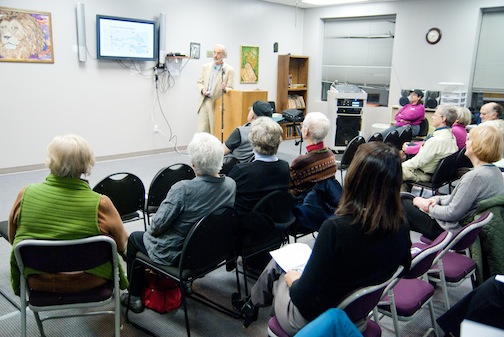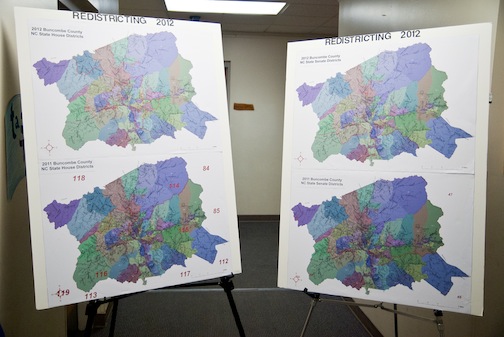Photos by Max Cooper
At a Feb. 22 forum hosted by the Asheville-Buncombe County League of Women Voters, Dr. George Peery sought to contextualize new Western North Carolina political districts that have “spawned shocked incredulity, smug sentiments of justifiable payback, outrage, support, and baffled indifference,” he said.
The redistricting process cuts to the heart of our democracy by dictating the boundaries of congressional as well as state House and Senate districts, said Peery, who serves as an emeritus professor of Political Science at Mars Hill College and as president of the World Affairs Council of WNC. The boundaries are redrawn every 10 years based on the latest census data.
In North Carolina, members of the General Assembly do the job, factoring in assorted geographic, cultural and partisan considerations. Last year, that power lay with the first Republican majority in over a century. And like the Democrats before them, GOP leaders drew the lines in ways designed to ensure they maintain power for years to come, said Peery to the roughly 30 forum attendees at the Jewish Community Center in Asheville.
In Buncombe County, the new borders of the Statehouse districts are intended to ensure Republican Rep. Tim Moffitt gets reelected in District 116 – and to improve the chances of a Republican getting elected in District 115, said Peery. The idea is to pack the city of Asheville’s big majority of Democrats in to District 114, essentially giving the opposing party that seat in order to try to minimize its influence over the county’s other two, he explained. It’s a tried and true redistricting strategy known as “packing,” he noted.
And with the dynamics of the 2012 election taking shape, it looks like its on track to be at least somewhat successful. Democratic Rep. Patsy Keever was drawn out of District 115 and has chosen to retire from the N.C. House rather than challenge Democratic colleague Susan Fisher to a primary in District 114. And as of now, Republican Nathan Ramsey is the only candidate running to replace Keever in the 115th. Moffitt faces a challenge from former Democratic House Rep. Jane Whilden – she beat him by a narrow margin in 2008 but lost handily to him in 2010. And the district, which stretches from Arden in the South to Sandy Mush in the northwest, encompasses the most conservative part of the county – consisting of even more registered Republicans under the new maps than it did when he beat her in 2010.

Meanwhile, the GOP drew most of Asheville out of its longtime home in the 11th Congressional district, making the district one of the most conservative districts in the state. Incumbent Democratic Rep. Heath Shuler recently announced that after winning three terms, he’ll retire. “I think he saw the writing on the wall,” said Peery. An energetic and well financed group of Republicans are currently battling in the primary to represent their party—the winner is likely to beat whichever Democrat they face and win the seat, he said.
Now, most of Asheville is in the 10th District. But the remainder of the district, which stretches southeast all the way to Gaston County, is so heavily conservative, that incumbent Republican Rep. Patrick McHenry is likely to win reelection – despite the influx of the city’s more liberal voters, said Perry.
Because of the redistricting techniques that were used here and across the rest of the state, the General Assembly and majority of North Carolina’s congressional seats are likely to be taken by Republicans this year, he said. In contrast, in the at-large winner takes all presidential contest – which is less subject to the influence of redistricting – the state is expected to be a swing state, with Democratic President Barack Obama having a good chance of winning it, Peery noted.

Administering elections in all of Buncombe’s new districts – combined with a new district election system for county commissioners that was also engineered by Republicans in Raleigh – will be costly to the county board of elections, said Peery. The changes are expected to cost Buncombe taxpayers $100,000 to $150,000 in material and administration costs, he reported. One precinct in Skyland at the intersection of many of the new districts will require 24 different ballots, he said. Others in the county will need 16 or 17, he said.
But as blatantly partisan as the new districts in WNC might be, Peery said they seem fair compared to many districts that have been drawn throughout history in other parts of the country.
And pending legal challenges to the districts aren’t likely to be successful at changing the lines, Perry said. Earlier this month, a three-judge panel considering the concerns of Democrats and independent groups – who argue the districts violate the equal voting rights of minorities – ruled that the May 8 primary will go ahead as planned under the new maps.
“That’s not a good sign for those hoping the maps will change,” Peery noted.
Meanwhile, some groups, including the League of Women Voters, are advocating for the N.C. General Assembly to hand off control over redistricting in the future to an independent committee. A bill doing so was passed last year in the Statehouse but is currently languishing in the senate.
“Independent redistricting committees are in their infancy, but it looks like they work better,” said Peery, noting that states using the process such as Iowa have been plagued with less partisanship and fewer law-suits.




“GOP leaders drew the lines in ways designed to ensure they maintain power for years to come”
Wow, nobody ever did THAT before.
Where was Dr. Perry 4 years ago?
……………..
Can you not READ?!? The beginning of that sentence is, “And like the Democrats before them,”. What is wrong with you?
What is wrong with you?
New to town much? We stopped asking what’s wrong with Tim(1) a long time ago.
Good point, tho’…